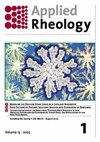沥青材料粘弹性函数的主曲线构造
IF 1.8
4区 工程技术
Q1 MECHANICS
引用次数: 0
摘要
沥青材料的性能通常使用线性粘弹性区域内测量的流变特性进行评估。如果所有弛豫时间都与温度有关,那么在不同工作条件下获得的数据就可以转换成对数刻度,在对数刻度上,这些数据部分重叠并合并成一条主曲线。这就是众所周知的时间-温度叠加原理,该原理已成功应用了几十年。然而,由于该方法的经验性质,在绘制主曲线时使用了许多不同的程序。此外,计算能力的不断提高也催生了新的方法,例如对所代表的粘弹性函数进行同步建模。忽略了方法的基本说明,是这一系列可用方案的隐性缺点,有可能在构建主曲线时出现假象和不协调。本综述总结了这些基本声明以及多年来发展起来的经验和现象学方法。本研究的目的是帮助读者选择最合适的方法来构建主曲线。虽然综述的主题具有普遍应用性,但重点放在了沥青领域。本文章由计算机程序翻译,如有差异,请以英文原文为准。
Master curves construction for viscoelastic functions of bituminous materials
The performance of bituminous materials is often evaluated using rheological properties measured within the linear viscoelastic region. If there is a univocal temperature dependence of all the relaxation times, data obtained in different operating conditions can be translated onto a logarithmic scale where they partially overlap and merge into a single master curve. This is the well-known time–temperature superposition principle that has been successfully applied for decades. However, the empirical nature of the method has led to many different procedures being used for the graphical construction of the master curve. In addition, the continuously increasing calculating power has led to new approaches, such as the simultaneous modelling of the represented viscoelastic function. Losing track of the basic statements of the method is the hidden drawback of this wide range of available protocols with the risk of artefacts and incongruences being introduced in the construction of the master curves. This review summarizes these basic statements together with the empirical and phenomenological approaches developed over the years. The aim of this study is to help the reader in choosing the most appropriate method to build the master curves. Although the subject of the review is of general application, the field of bitumen is focused on.
求助全文
通过发布文献求助,成功后即可免费获取论文全文。
去求助
来源期刊

Applied Rheology
物理-力学
CiteScore
3.00
自引率
5.60%
发文量
7
审稿时长
>12 weeks
期刊介绍:
Applied Rheology is a peer-reviewed, open access, electronic journal devoted to the publication in the field of applied rheology. The journal provides the readers with free, instant, and permanent access to all content worldwide; and the authors with extensive promotion of published articles, long-time preservation, language-correction services, no space constraints and immediate publication.
 求助内容:
求助内容: 应助结果提醒方式:
应助结果提醒方式:


